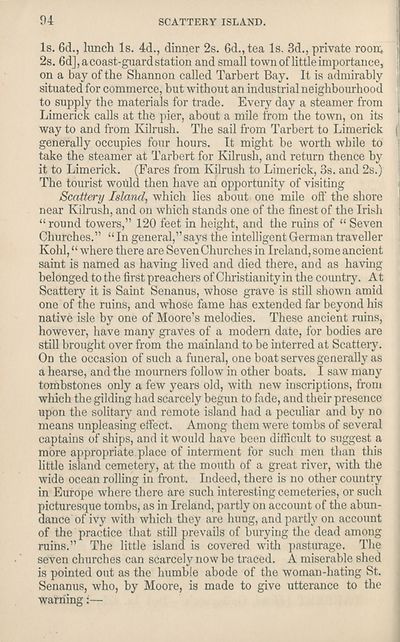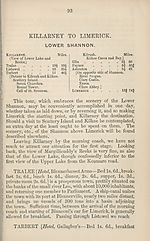Download files
Complete book:
Individual page:
Thumbnail gallery: Grid view | List view

94
SCATTERY ISLAND.
Is. 6d., lunch Is. 4d., dinner 2s. 6d.,tea Is. 3d., private roon,
2s. 6d], a coast-guard station and small town of little importance,
on a bay of the Shannon called Tarbert Bay. It is admirably
situated for commerce, but without an industrial neighbourhood
to supply the materials for trade. Every day a steamer from
Limerick calls at the pier, about a mile from the town, on its
way to and from Kilrush. The sail from Tarbert to Limerick
generally occupies four hours. It might be worth while to
take the steamer at Tarbert for Kilrush, and return thence by
it to Limerick. (Fares from Kilrush to Limerick, 3s. and 2s.)
The tourist would then have ah opportunity of visiting
Scattery Island, which lies about one mile off' the shore
near Kilrush, and on which stands one of the finest of the Irish
“ round towers,” 120 feet in height, and the ruins of “ Seven
Churches.” “In general,’’says the intelligent German traveller
Kohl, “ where there are Seven Churches in Ireland, some ancient
saint is named as having lived and died there, and as having
belonged to the first preachers of Christianity in the country. At
Scattery it is Saint Senanus, whose grave is still shown amid
one of the ruins, and whose fame has extended far beyond his
native isle by one of Moore’s melodies. These ancient ruins,
however, have many graves of a modem date, for bodies are
still brought over from the mainland to be interred at Scattery.
On the occasion of such a funeral, one boat serves generally as
a hearse, and the mourners follow in other boats. I saw many
tombstones only a few years old, with new inscriptions, from
which the gilding had scarcely begun to fade, and their presence
upon the solitary and remote island had a peculiar and by no
means unpleasing effect. Among them were tombs of several
captains of ships, and it would have been difficult to suggest a
more appropriate place of interment for such men than this
little island cemetery, at the mouth of a great river, with the
wide ocean rolling in front. Indeed, there is no other country
in Europe where there are such interesting cemeteries, or such
picturesque tombs, as in Ireland, partly on account of the abun¬
dance of ivy with which they are hung, and partly on account
of the practice that still prevails of burying the dead among
ruins.” The little island is covered with pasturage. The
seven churches can scarcely now be traced. A miserable shed
is pointed out as the humble abode of the woman-hating St.
Senanus, who, by Moore, is made to give utterance to the
warning:—
SCATTERY ISLAND.
Is. 6d., lunch Is. 4d., dinner 2s. 6d.,tea Is. 3d., private roon,
2s. 6d], a coast-guard station and small town of little importance,
on a bay of the Shannon called Tarbert Bay. It is admirably
situated for commerce, but without an industrial neighbourhood
to supply the materials for trade. Every day a steamer from
Limerick calls at the pier, about a mile from the town, on its
way to and from Kilrush. The sail from Tarbert to Limerick
generally occupies four hours. It might be worth while to
take the steamer at Tarbert for Kilrush, and return thence by
it to Limerick. (Fares from Kilrush to Limerick, 3s. and 2s.)
The tourist would then have ah opportunity of visiting
Scattery Island, which lies about one mile off' the shore
near Kilrush, and on which stands one of the finest of the Irish
“ round towers,” 120 feet in height, and the ruins of “ Seven
Churches.” “In general,’’says the intelligent German traveller
Kohl, “ where there are Seven Churches in Ireland, some ancient
saint is named as having lived and died there, and as having
belonged to the first preachers of Christianity in the country. At
Scattery it is Saint Senanus, whose grave is still shown amid
one of the ruins, and whose fame has extended far beyond his
native isle by one of Moore’s melodies. These ancient ruins,
however, have many graves of a modem date, for bodies are
still brought over from the mainland to be interred at Scattery.
On the occasion of such a funeral, one boat serves generally as
a hearse, and the mourners follow in other boats. I saw many
tombstones only a few years old, with new inscriptions, from
which the gilding had scarcely begun to fade, and their presence
upon the solitary and remote island had a peculiar and by no
means unpleasing effect. Among them were tombs of several
captains of ships, and it would have been difficult to suggest a
more appropriate place of interment for such men than this
little island cemetery, at the mouth of a great river, with the
wide ocean rolling in front. Indeed, there is no other country
in Europe where there are such interesting cemeteries, or such
picturesque tombs, as in Ireland, partly on account of the abun¬
dance of ivy with which they are hung, and partly on account
of the practice that still prevails of burying the dead among
ruins.” The little island is covered with pasturage. The
seven churches can scarcely now be traced. A miserable shed
is pointed out as the humble abode of the woman-hating St.
Senanus, who, by Moore, is made to give utterance to the
warning:—
Set display mode to:
![]() Universal Viewer |
Universal Viewer | ![]() Mirador |
Large image | Transcription
Mirador |
Large image | Transcription
| Antiquarian books of Scotland > Ireland/Irish > Black's guide to Killarney and the south of Ireland > (106) |
|---|
| Permanent URL | https://digital.nls.uk/118861940 |
|---|
| Description | Thousands of printed books from the Antiquarian Books of Scotland collection which dates from 1641 to the 1980s. The collection consists of 14,800 books which were published in Scotland or have a Scottish connection, e.g. through the author, printer or owner. Subjects covered include sport, education, diseases, adventure, occupations, Jacobites, politics and religion. Among the 29 languages represented are English, Gaelic, Italian, French, Russian and Swedish. |
|---|

